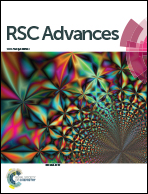Synthesis of ZnO nanorods on a flexible Phynox alloy substrate: influence of growth temperature on their properties†
Abstract
A novel flexible alloy substrate (Phynox, 50 μm thick) was used for the synthesis of zinc oxide (ZnO) nanorods via a low-temperature solution growth method. The growth of ZnO nanorods was observed over a low temperature range of 60–90 °C for a growth duration of 4 hours. The as-synthesized nanorods were characterized using field-emission scanning electron microscopy (FE-SEM), X-ray diffraction (XRD), transmission electron microscopy (TEM), and X-ray photoelectron spectroscopy (XPS) for their morphology, crystallinity, microstructure and composition. The as-grown ZnO nanorods were observed to be relatively vertical to the substrate. However, the morphology of the ZnO nanorods in terms of their length, diameter and aspect ratio was found to vary with the growth temperature. The morphological variation was mainly due to the effects of the various relative growth rates observed at the different growth temperatures. The growth temperature influenced ZnO nanorods were also analyzed for their wetting (either hydrophobic or hydrophilic) properties. After carrying out multiple wetting behaviour analyses, it has been found that the as-synthesized ZnO nanorods are hydrophobic in nature. The ZnO nanorods have potential application possibilities in self-cleaning devices, sensors and actuators as well as energy harvesters such as nanogenerators.


 Please wait while we load your content...
Please wait while we load your content...